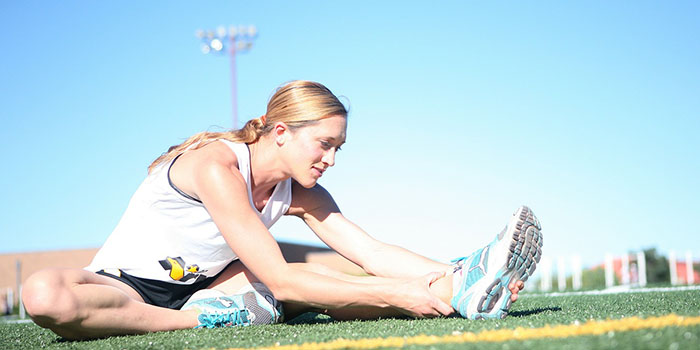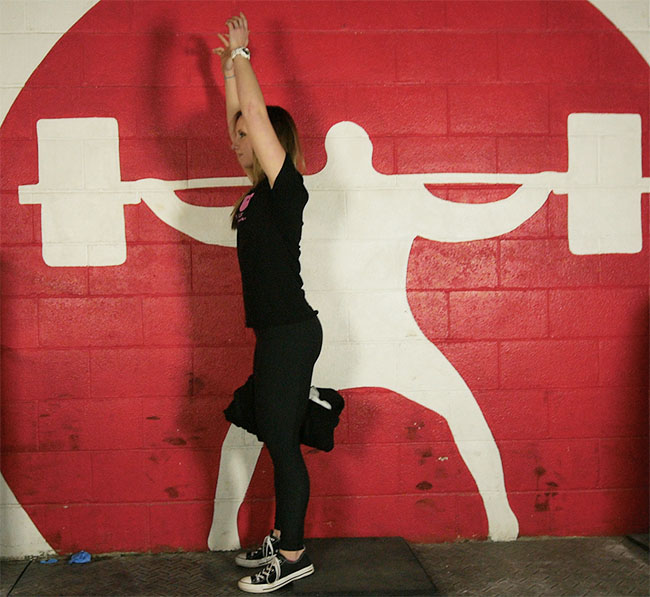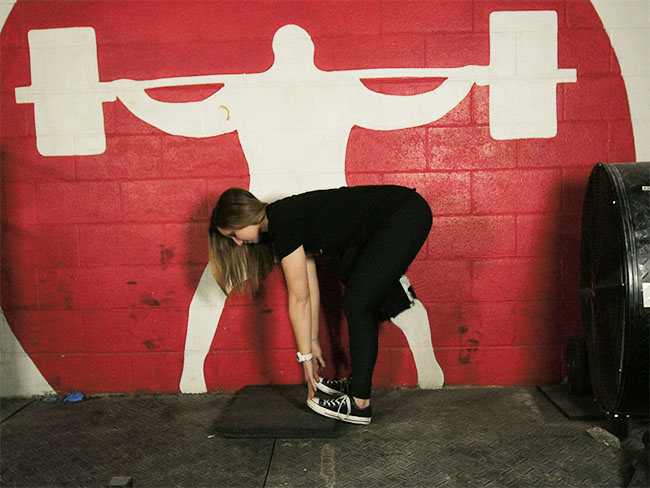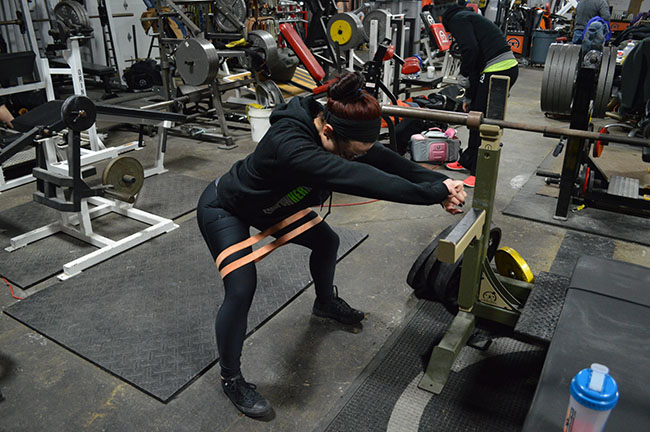
A lot has been written about movement screening, corrective exercises, mobility, stability, and activation exercises over the past several years. As a result, we have begun spending an inordinate amount of time working on corrective exercises that, much of the time, make little or no true movement change. One of the reasons for this wasted time is that we have a fundamental misunderstanding of how to correct movement dysfunctions. I want to share several very important concepts that I have learned over the past couple years regarding movement. To do so, I am going to use one of the easiest and most telling screens there is: the standing toe touch.
I will be very clear: I cannot and will not claim any of these concepts to be mine. People much smarter than myself have been using this thought process for a long time. So many people have used these concepts that it is very unclear who I should even cite when referring to them. I’ll do the best I can to credit those responsible at the end of this article. But here are some simple rules to live by when looking at movement.
1) The nervous system perceives instability as a much greater threat than immobility.
2) The body will behave differently in weight bearing positions than non-weight bearing positions.
3) Gradating tension for task-specific stability is a skill that must be practiced.
Let’s look at these rules one at a time.
Rule #1: The nervous system perceives instability at a much greater threat than immobility.
Our body can adapt in unbelievable ways. If we lack the motor control about a specific joint, our nervous system will adapt simply be restricting available mobility at that joint. This is typically done through neurological toning of muscles.
Do this test: Stand up as tall as you can. Put your hands on your hamstrings. Slowly rock you bodyweight forward on your toes and backwards on your heels and pay attention to what is going on in your hamstring. As you rock forward, you should feel your hamstring tensing. As you rock back, it releases. You weren’t consciously telling your hamstring to fire, you weren’t flexing your knee, and you weren’t actively extending your hip. This is a case of your nervous system using your hamstrings as a stabilizer, basically stopping you from falling on your face. Imagine if a more subtle type of this instability is felt over the long term. How would your tissues and joint capsules adapt? Imagine how stiff you may feel. And if this stiffness was caused by instability, what are the chances that mobilization exercises will cause permanent change?
Now think about the toe touch. When you ask someone to perform a toe touch, it will require them to display a posterior weight shift at their pelvis, very similar to a deadlift or a squat. If the weight shift is not there, if they don’t have the motor control, their attempt to touch their toes will be stopped by their hamstrings toning up in order to avoid falling forward. What they will feel, and probably will tell you, is that they have tight hamstrings. Teaching them to weight shift using an exercise such as Gray Cook’s toe touch progression will clean up their toe touch and teach them a new motor pattern that transfers very well into hip hinging.

In the toe touch pictures in this article, you see the toe touch progression being performed from two different positions. In the first picture, the athlete’s heels are elevated. This position forces a posterior weight shift because shifting weight forward at all will result in falling over. This variation can be tough for those athletes that are strongly patterned to weight shift improperly. In the second picture, the athlete has her toes elevated, which offers her no choice but to shift her hips backward. The towel between the legs is used to sequence the deep front line for stabilization (a topic for another article). When used with the right athlete, this exercise can be magical in changing movement and is essential in beginning phases of teaching athletes to load their hips. You’d be surprised how many people have knee pain, cannot load their hips properly when they squat, and also cannot touch their toes due to lack of a weight shift.
But what if a posterior weight shift isn’t the problem? What if the hamstring tone is covering something else up? What if the athlete has spinal flexion instability? The hamstrings could very easily be an attempt of the nervous system to stop the athlete from going into lumbar flexion and avoid blowing a disc. This is very often seen as a cause of lumbar disc injuries and low back pain. While I agree with that to some extent, I have found that stabilizing the flexion pattern relieves a lot of the neurological hamstring tone. If the problem is instability, stretching the hamstring will do very little for improving motion. Restoring spinal stability through rolling patterns or teaching them to engage the deep front line (again, a separate article would be needed to describe the DFL) will allow the nervous system to calm down and let the hamstrings relax.
An exercise to aid in this is a supine rolling pattern with the upper extremities. In order to roll in a segmental fashion, the athlete must show good segmental stability. Lack of segmental stability will result in global movers halting a smooth roll. If you’ve never thought of the quads as being neck stabilizers, watch someone with poor spinal stability pick their head up to roll. As soon as the cervical spine flexes, their legs will extend and their feet will raise right off the ground.
Rule #2: The body will behave differently in weight-bearing positions and non-weight-bearing positions.
This rule gets to the core of stability. As the demand for stability goes up, mobility goes down. How many times have you seen the super-flexible person who can lay on the ground and awe you with crazy range of motion, but can’t display a solid squat on their feet? And when you add load, forget about it. They fold right up. Refer back to Rule #1. If your nervous system senses instability, it will restrict motion. This is why you must get a clear picture of how someone moves in weight-bearing and non-weight-bearing positions.
Try this test: Stand with your feet together and touch your toes. If you cannot touch your toes, sit down on the ground with your legs straight in front of you and try to touch them from there. Go as far as you can. In a lot of cases, people will be unable to touch their toes in standing then touch them easily (or at least get much closer) in sitting. It should actually be easier to touch your toes in standing with the help of gravity, but often this is not the case.
What you are seeing between those two-toe touch variations is the impact weight-bearing has on your athlete. For those that have a lot easier time touching their toes in a seated position, we can hypothesize that their hip stability is probably a movement issue. For those that actually get worse in a seated position we may hypothesize that we are seeing true mobility problems. But be careful; while the hips are unloaded in a long-sitting position, the spine is actually still loaded (just to a lesser extent). Spinal stability could still play a role.
For those that show a great amount of hip instability, using exercises that challenge them to create stability in progressively demanding positions will help greatly. Progressions that follow the quadruped, half-kneeling, split-stance, and single-leg stance sequence will work wonders for teaching these athletes to properly stabilize in increasing demanding positions. For the toe touch pattern in particular, use the chop exercise in various postures to stabilize flexion (lifts are an extension-based movement).
The chop exercises in various postures can stabilize the toe touch (flexion) pattern. An athlete can develop the motor control to stabilize through their left hip (down knee) in a flexion pattern.
Rule #3: Gradating tension for task-specific stability is a skill that must be practiced.
Imagine getting ready to hit a 600-pound deadlift (for me this is a max effort attempt, maybe not for you). You grab the bar, get set, put your fingerprints into the bar, inhale into your belt, brace your abs, then lift. What you are doing is learning to create as much tension as possible in order to lift a heavy load. This type of stability and stiffness is great, but only in this scenario. In this case, you are lifting a heavy load at a slow speed. This same type of strategy won’t work for you in a different task.
Imagine swinging a baseball bat. You grab the bat, put your fingerprints into the bat, inhale and brace, then try and swing. This changes everything about your swing. Chances are you won’t display great bat speed and your swing won’t be fluid at all. What we are seeing is the difference in task-specific tension. Other activities like Olympic lifting fall somewhere in the middle.
In physical therapy, we see a lot of people come with chronic low back pain. Generally, these people have a huge amount of tone in their lumbar paraspinals. What they display is an inability to shift their stability strategy from a “high threshold” strategy (what we would use to deadlift 600 pounds) to a “low threshold” strategy (think about picking up a pencil). The result is that their body’s nervous system behaves as if they are deadlifting 600 pounds when they reach down to pick up a pencil. Over time this obviously can cause some pain.
This brings me to a very important point. There is a very distinct difference between training someone for a performance objective versus a therapeutic one. As a therapist, a lot of times I want an athlete to display the appropriate movement pattern with the least amount of muscular tension possible. This is done in order to teach the athlete to stabilize without the use of global movers. I want them to display appropriate parasympathetic breathing during these exercises as well. But understand that this is done for a very specific reason. I am trying to correct possible dysfunction, not improve athletic performance. There may be some carryover from one to the other but my intention for how I choose to perform a task must be very clear.
If I am acting as a performance coach, I may encourage a “high-threshold” strategy. Teach them to breath, brace, and create tension because I want them to display and develop force. But I also need to understand that this type of strategy will only work in specific scenarios. Training them to fluctuate this tone for different tasks is key. Think about the differences between powerlifting, Olympic lifting, swinging a bat, and shooting a basketball. All require different levels of tension for the nervous system to stabilize and perform. Just think about how many powerlifters are stuck in a “high threshold” strategy. Imagine them swinging a bat or shooting a basketball. Not very fluent? These are movement skills that must be practiced.
How many of you know someone who cannot perform a solid bodyweight squat but if you put a barbell with some weight on their back they can drop right down? This is a case of someone not being in touch with their low tension (“low threshold”) side. The added weight allows them to generate some tension and engage their “high threshold” side. Their nervous system feels stable and allows them to demonstrate mobility. I don’t like making generalizations, but a lot of time these people are not the most fluent of movers.
The toe touch is essentially looking at an athlete’s ability to stabilize into flexion in a low threshold environment. This is an important skill to have even if your sport calls you to move heavy loads. You never want to be the guy that throws his back out trying to put your shoes on in the morning.
Understand that tension changes from task to task. What is your intent? What are you preparing for? Getting “stuck” in one area or another may be advantageous for one task, very disadvantageous for another. Think about this: the FMS is a screen that primarily assesses non-tensioned movement skills (bodyweight movements). If you score very well on the FMS but get folded up with your bodyweight on your back when squatting, you’ve essentially demonstrated a skill set. This could be in your favor for some sports, but if you’re an offensive linemen, you better learn to create tension and stabilize against a load.
I need to credit those whose ideas these are. Gray Cook and the SFMA crowd are brilliant. Charlie Weingroff and Patrick Ward continue to put out great work. Thomas Knox at the Washington Wizards taught me a ton about practical application of these rules. Tyler Wilkins, the ATC I work with at EXOS is naturally-gifted at seeing these patterns in action.
Andrew Paul is a Performance Physical Therapist and Performance Specialist at EXOS in Gulf Breeze, FL. Prior to his time at EXOS, he was the Director of Transitional Therapy and Assistant Director of Strength and Conditioning at the University of Missouri for seven years where he worked with the University’s football, softball, and volleyball programs. He can be contacted at apaul@teamexos.com.











